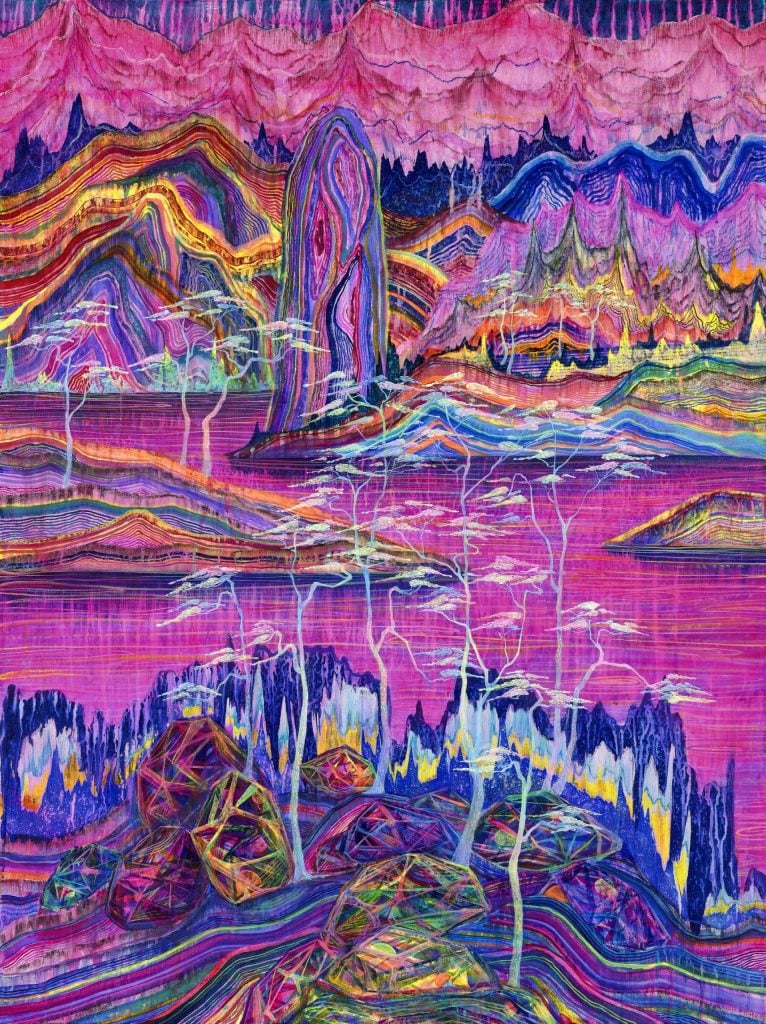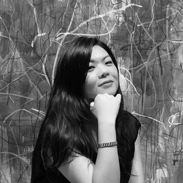Few in the Western art market had heard of Huang Yuxing before mid-2020, when one of his fluorescent-hued paintings cracked $1 million at Christie’s Hong Kong. Once a young artist notches a price like that, it doesn’t take long for international players to start paying attention.
Over the past year and a half, the Beijing-born artist has picked up global gallery representation and set several new auction records. In December, his Seven Treasure Pines (2016–19) fetched an eye-popping $8.3 million, besting his previous record by 424 percent and exceeding its high estimate by a factor of 13. Huang’s work generated more money at auction last year than blue-chip names like Nicolas Party and Jonas Wood, according to the Artnet News Pro Intelligence Report.
The surging prices for his paintings, which fashionably blend figuration, abstraction, and landscape, coincide with what may be a rebound of Chinese contemporary art more broadly.
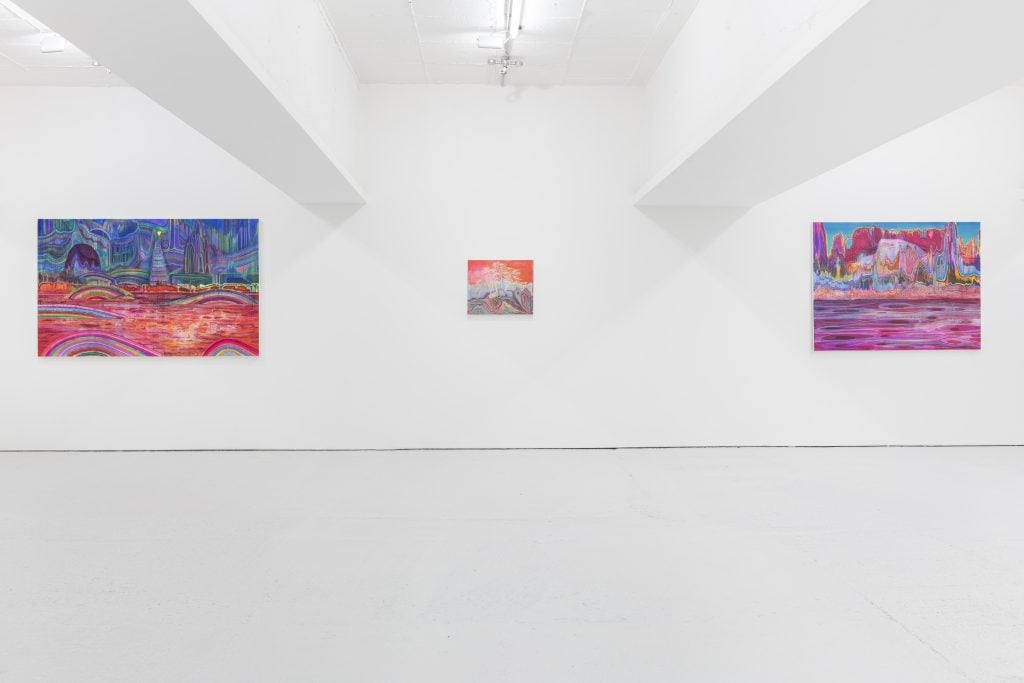
Installation view of Huang Yuxing’s show at Galerie König, London. Photograph by Damian Griffiths, 2019 Courtesy the artist and KÖNIG GALERIE Berlin, London, Tokyo.
The Return of Chinese Contemporary
While the rise of young Chinese collectors has been a major narrative in the market in recent years, Chinese contemporary art was slower to rebound from the Great Recession that hit in 2015, right after Chinese President Xi Jinping’s sweeping anti-corruption crackdown sent a number of high-ranking senior officials to jail.
That tide changed last year as millennial collectors began spending increased sums on young artists from China and abroad. Sales of Chinese ultra-contemporary art, defined as work by Chinese-born artists born after 1974, almost doubled, hitting $96.1 million, up from $49 million the year before, according to the Artnet Price Database.
Between 2019 and 2021, the category’s sales jumped almost 240 percent. The new bump is primarily driven by demand for painters like Huang, Jia Aili (born 1979), Zhao Zhao (b. 1982), and Liang Yuanwei (b. 1977).
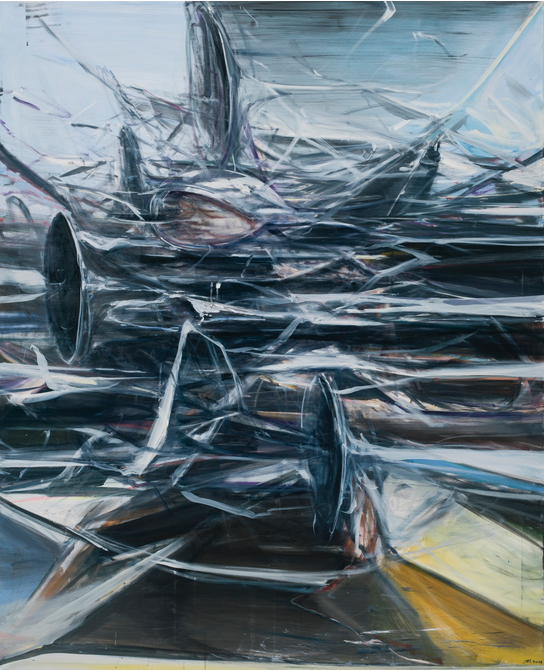
Jia Aili, Untitled (2009). Photo: Courtesy Sotheby’s.
“The contemporary art market is fueled by a younger generation that brings energy and new money,” veteran dealer Pascal de Sarthe told Artnet News. “The art market in recent years has expanded on all fronts and has outgrown art for art’s sake. It is now more than ever an asset and a form of investment. It adds an element that has not been on the scale up until the past decade or so, and everyone in the contemporary art world is enjoying the ride.”
In November, Phillips Hong Kong launched a new series called “Ultra/Neo,” dedicated to a generation of Chinese, Japanese, and Southeast Asian artists, largely born in the 1970s, whose work comments on the rapid technological and cultural developments they’ve witnessed. All 30 lots, offered across day and evening sales in association with Poly Auction, were sold, some for well above estimate. Six set new artist records.
Nevertheless, amid the economic uncertainties unleashed by overlapping geopolitical crises, some wonder whether this segment of the market, which has proven volatile before, has true staying power. In a market increasingly manipulated by speculation, do artists like Huang, whose prices have shot up at hyperspeed, have deep enough roots to weather an impending storm?
The Rise of Huang Yuxing
Born in Beijing, Huang graduated from the mural painting department at Central Academy of Fine Arts (CAFA), China’s leading art academy, in 2000.
In the years after graduation, Huang’s works appeared in various group exhibitions, with paintings often featuring Japanese anime characters like Astroboy. They gained some traction in local auctions but as the market lost interest in anime paintings around 2009, Huang lost his edge.
A long journey in the Himalayas toward the end of 2009 set him on a new course, according to Chinese media. This newfound focus on landscape earned him solo exhibition opportunities, including a 2014 show with Antenna Space in Shanghai.
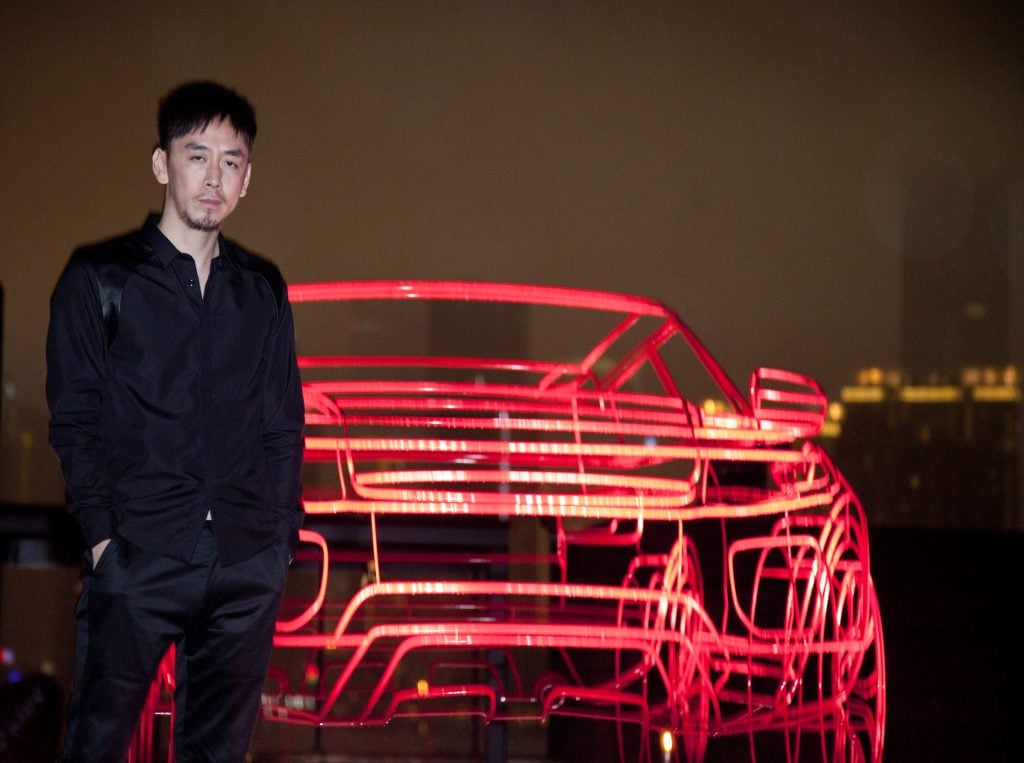
Huang Yuxing with the Range Rover Evoque wireframe on May 21, 2011 in Shanghai. (Photo by Kevin Lee/Getty Images for Range Rover Evoque)
Huang’s big break came the next year. He had a solo show at the Shanghai Minsheng Art Museum, became the first guest artist at the Yuz Museum Project Room, and began developing a modest secondary market presence with $323,917 in total sales. After dealer Johann König encountered his work at Art Basel Hong Kong, he gave him a solo show in London in 2019. It sold out at prices ranging from $20,000 to $100,000.
Meanwhile, steam was picking up at auction. The year of the König show, his work generated $1.6 million. That figure increased by a factor of nearly six in 2020, and rose again in 2021 with $19.9 million in sales. The average Huang fetched $326,816 at auction that year—more than his work made cumulatively in all of 2015. At Christie’s Hong Kong on May 27, Huang’s Cherry Blossom Ravine (2019) fetched more than HK$6.9 million ($883,177), nearly 10 times expectations.
What’s the Draw?
Huang’s contemporary twist on landscape—the subject of traditional Chinese ink paintings for centuries—helped him develop a dedicated Chinese collector base. In recent years, his admirers have expanded to include Western collectors and institutions such as the Institute of Contemporary Art, Miami.
“Collectors who are perhaps largely millennials or even from Gen Z relate very much to this color system as it calls to mind the Y2K aesthetic which is very distinctive and inspired by the mid-’90s and early 2000s,” said Danielle So, head of the contemporary art day sale at Phillips Hong Kong.
Huang’s star status was confirmed when Louis Vuitton featured his work on its Capucines handbag last year, placing him among the ranks of Vik Muniz, Zeng Fanzhi, and Paola Pivi. “The bag will accompany different conversations and different everyday activities, rather than simply remain static in an exhibition,” the artist told the media at the time.
Starmaking gallery Almine Rech began representing Huang in 2020, before presenting a sold-out exhibition of his work in Brussels. In an effort to expand his collector base, Rech reported selling all 21 works to American and European collections. “His well-executed details and impressive use of color make him stand out from his peers,” said Eileen Wang, the gallery’s Shanghai director.
Flipping Advisory?
In the current red-hot contemporary art market, spiking sales can sound a note of caution—if collectors buy an artist’s work at inflated prices, they might give up and cash out, while the financialization can put off curators and others who might help ensure that artist’s career longevity. Some observers worry that Huang, as well as other young artists on the rise, could fall victim to this cycle.
“Being caught in a speculative market is an artist’s worst nightmare,” de Sarthe warned, citing a previous contemporary art market boom in the late 1980s that “left so many casualties behind.” The dynamic hurts the collector who overpaid, too. “The real problem is that very few collectors right now buy art with their eyes. Most of them are just following the trends,” de Sarthe said.
Today’s market is “most comfortable” with paintings with detailed brushstrokes and intense colors that put a contemporary twist on traditional styles like Surrealism or abstraction, de Sarthe observed. “The bad news is, in some cases, the growth can leave the artist with little room for error as they reach record prices within their first year of success,” he said.
There are signs of churn already. Huang’s 20 top lots at auction were all sold in 2020 or later. Fourteen are recent works, having been created in or after 2015; four of those 14 were completed in 2019. (That includes his record-setting Seven Treasure Pines and White Building in the Forest, which was acquired by a European collector from the König London show in 2019 and sold for $497,782 at Sotheby’s Hong Kong in April.)

Huang Yuxing, Seven Treasure Pines (2016–19). Courtesy of Christie’s.
The quick turnaround has caught the attention of some art advisors who, speaking on the condition of anonymity, said that work coming back on the market in less than five years is a warning sign. Two of Huang’s top 20 lots represent repeat sales, having been purchased at auction in 2018 and 2019 and resold in 2021.
But market players invested in Huang’s success have a different opinion, and say they are working to put the brakes on his runaway market. Almine Rech has implemented a five-year non-resale agreement for the artist’s new work ahead of his first solo exhibition in New York later this year. New primary-market prices are yet to be confirmed.
Ada Tsui, the head of the day sale in Christie’s Asia Pacific 20th and 21st century art department, described Seven Treasure Pines as “an exceptional case” and said “the market for Huang’s work has become stable.” Phillips’s So agreed that the $8.3 million record is likely to stay in place for a while.
But with his growing exposure in the West, demand for Huang’s colorful paintings is unlikely to die down anytime soon. The waiting list for his new work is long, and many collectors have been in line for up to two years already, Almine Rech’s Wang said.
The artist “can hardly be categorized as prolific,” she noted. “Sometimes, he spends half a year traveling without working. Sometimes, he stays in his studio all day to create passionately.”
To be a fan of Huang’s, it seems, patience—and a big fat wallet—are essential.
Follow Artnet News on Facebook:
Want to stay ahead of the art world? Subscribe to our newsletter to get the breaking news, eye-opening interviews, and incisive critical takes that drive the conversation forward.
